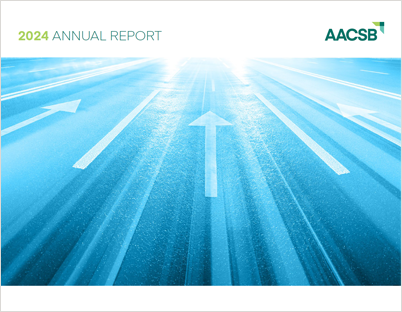Designing the Application Process to Reduce Academic Fraud
Sponsored Content
The rapid spread of COVID-19 left no industry unaffected, and the education sector was certainly no different. Almost overnight, face-to-face interactions and classroom-based teaching were suspended. Thankfully, the majority of institutions were able to adapt and deliver their programs in the online environment.
As many businesses and educational institutions transitioned to virtual operations, it seemed as if the whole world was home all at once. For many, this provided a period of reflection and some downtime to dedicate toward professional development. At the same time, an incredibly tough economy stemming from the pandemic caused businesses to close their doors and unemployment rates to rise. As a result, business schools and MBA programs reported a surge of applications in 2020.
The Increasing Emergence of Academic Fraud
Of course, higher application rates and an increase in the instances of academic fraud go hand in hand. For the vast majority of business school students, the application process involves providing authentic documentation to support their submissions. Yet, despite the fact that a minority of applicants engage in academic fraud, the consequences can be incredibly damaging for higher education institutions.
Academic fraud exists in many forms, and thanks to technology, its sophistication is ever-evolving. To increase their chances of admission into business school programs, some applicants may exaggerate their existing certifications or diplomas, while others may completely fabricate their entire professional histories.
Especially when the market gets tough, applicants are often emboldened to try their hand at fraudulently embellishing their applications. A lot of the basic tactics are already known by admissions teams: These include printed school seals, unusually short study times, and names of fake universities that sound remarkably similar to legitimate (often prestigious) universities.
In pre-COVID-19 times, while some graduates took to the stage to accept the diplomas they had rightfully earned through hard work and study, other unscrupulous candidates accepted their own “degree certificates” within a few clicks. Diploma mills have been gaining momentum, and due to improved technology and resources, the documents they produce are entirely believable at first glance.
The Consequences of Academic Fraud
Aside from granting someone access to an educational program through deceptive means, it goes without saying that the implications of academic fraud can be devastating for educational institutions. When schools discover they have admitted students based on fraudulent information, they can suffer reputational risk, loss of professional integrity, reductions in admissions and revenue, and the stress of potential legal action. Not to mention that admitting fraudulent students takes places away from legitimate applicants.
Academic fraud also can have a devastating effect on a university’s reputation. It can be expensive and time-consuming for a school to change public perception once that perception has been tainted. Such reputational damage also can directly impact profits, awarded projects, and opportunities for future students.
Weeding Out the Fakes
That said, a cursory glance at an applicant’s submitted credentials does not—and should not—equal verification. The only trusted means of accurately verifying a professional document is via primary source verification (PSV). PSV refers to the act of verifying the information provided on a document such as a diploma or employment certificate by going directly to the source who issued it—this process delivers the highest levels of quality and accuracy on the market. For example, contacting an official university representative and requesting that they formally verify each piece of information provided on an application is 100 percent accurate.
This does not necessarily mean that the process should be manual or offline; many quality verification platforms integrate with existing systems used for managing and tracking applications. Having a tool that integrates with a school’s current technological system—such as Oracle, Salesforce, SAP Success Factors, Microsoft 365, and others—streamlines verification and keeps all aspects of the application process in one place. Such integration makes fraudulent admittance requests quick to pinpoint.
Combatting Academic Fraud With Blockchain Technology
As mentioned previously, technology opens the door a little bit further for instances of academic dishonesty. But emerging technologies also provide a powerful solution for eradicating academic fraud. If all institutions were on board with strategies for eradicating fraudulent applications, we would see the number of diploma mills and fake universities dwindle.
The very nature of blockchain makes fabricating information impossible. In simple terms, a blockchain is a shared file which records transactions. Each of the transactions, such as a piece of identifying information, is added in as a “block” and is stored as decentralized data in the chain. This means that once the information is added in, no one can interfere with or control its content. It also means that not only is the data incredibly secure, it cannot be tampered with.
In practice, business schools could request that their students be pre-screened ahead of admission by providing verified copies of their professional documents from a reputable verification provider. Blockchain takes this one step further: Students can submit copies of their verified credentials, which can be checked against the blockchain for their legitimacy.
Encouraging a Verified Career Journey
Making verification an integral part of an individual’s professional profile has countless benefits for business schools. Alumni can verify their diplomas, strengthening the perception that the institution produces high-quality students. By storing these verifications on blockchain, these former students can have their verified documents at their fingertips whenever needed, bolstering the strength of their job applications and building trust within their peer networks.
It’s clear that the use of blockchain-based verifications within the university admissions process is essential in combating academic fraud. Now, widespread adoption is key in order to create a technology-based barrier that fraudulent applicants, diploma mills, and fake universities cannot cross.
TrueProfile.io works with universities and employers to prevent academic fraud via a digital, on-demand primary source verification (PSV) solution, which is stored using blockchain technology. TrueProfile.io is part of the DataFlow Group, a leading global provider of specialized PSV solutions, background screening, and immigration compliance services since 2006.





